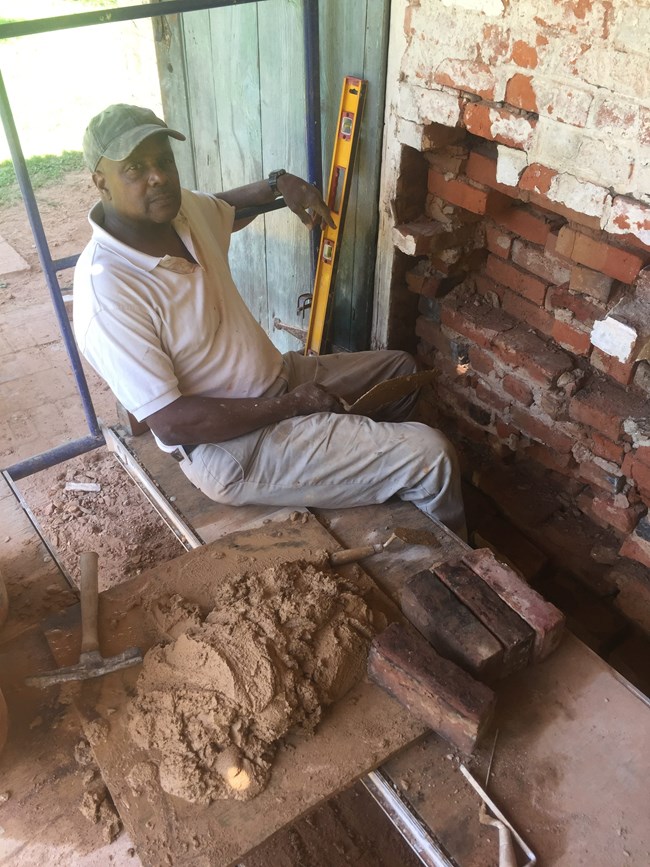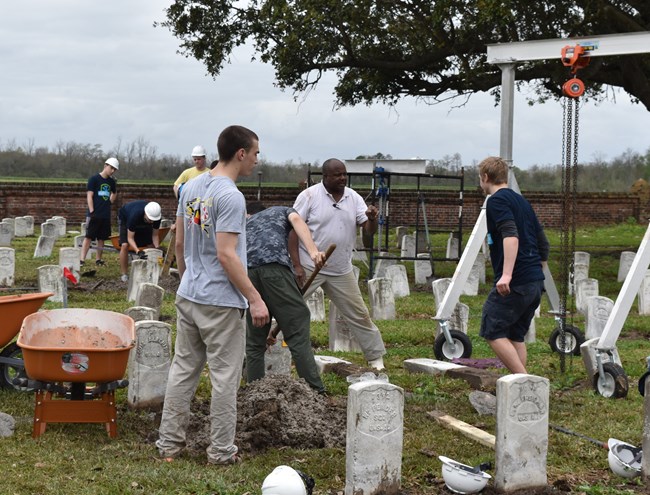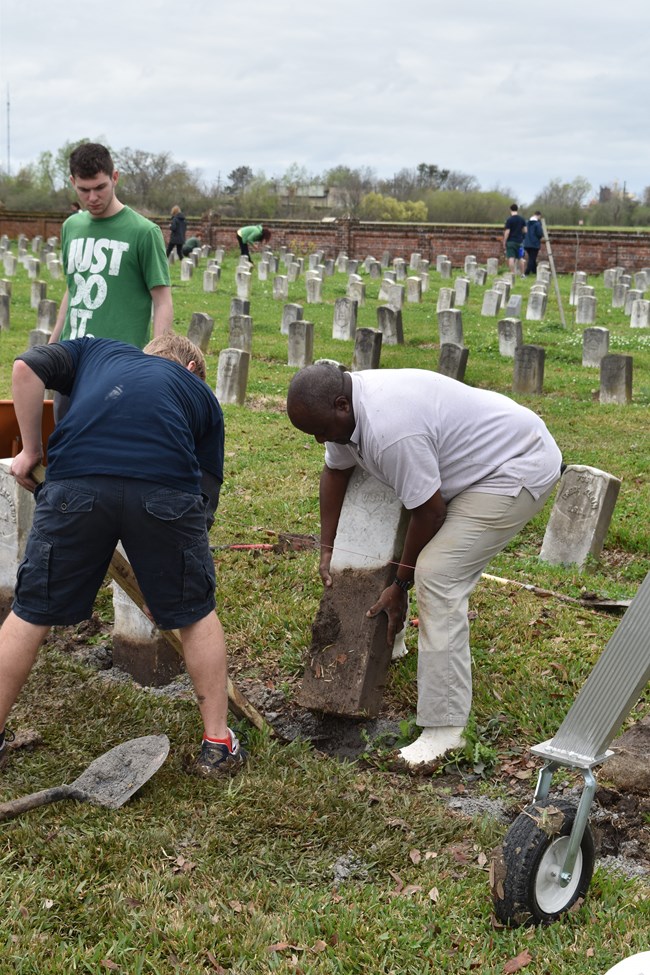Last updated: April 7, 2025
Article
Podcast 090: Building a Career in Historic Masonry

National Park Service
Born into Masonry
Theodore Pierre: I was born into it.
My dad, in 1971 was cited by the local chapter of the AIA in New Orleans as craftsmen of the year. He had that kind of reputation. He was respected.
I’m his namesake, because my name is Theodore Pierre, Jr. And I was his only son, and I just happened to really like what he did.
He built his own house. We had a working fireplace. We had a fountain in the yard. He was a major influence in my life.
My mother on the other hand, was a woman with some education. She had education.
So, I was caught in a kind of a nexus between the physical work, my dad’s occupation, and my mother who wanted me to do something academic. At least get a college degree.
But she didn't have any problem with me emulating my dad. It was just something that I did.
From the day I was 12 years old, he told me, "All right, tomorrow morning you're coming out to work with me."
And from that point on, I worked with him every Saturday, every weekend, during the summers. I had a built in job and that continued all the way through the time when I graduated from college.
College First: Apprenticeship Next
The day I finished college, I handed them my degree and I said, "Okay. For the next three or four years I'm going to be your apprentice. I'm going to work for you every day. No more school getting in the way of me learning what I could learn from you."
And he this fabulous repertoire of projects that he could select on his own. To decide, well, I'm going to go do a fountain over, here or I'm going to do a fireplace over here.
And it wasn't until much later in my life that I realized what he was doing was he was selecting those projects to give me experience in those areas. Yeah, we could've just done brick veneer every day. And some people did that, and they became really good at it. Fast and accurate and so on. But that's not what he did.
It was also a turnkey operation. We get a job, we did all our own site prep, all our grading. That's where I learned all of that, the whole schmear. And I learned it from the ground up, basically the ground up, the way craftsmen taught their sons in the 1960s and 70s. That's what my dad was doing with me.
I worked with him for about five years. And then decided I wanted to go and do some other things. And then I went back to it. I just decided, I tried working in an office for awhile. Because, I had a degree in architecture and of course, there was always the idea of me perhaps starting an architectural firm and that sort of thing.
Just wasn't for me because I hated working indoors. It just didn't work for me. Not only the working indoors, but the finished product. I like the physical finished product and I like to be able to claim the finished product. That's just the way I'm built.
Historic Masonry
Jason Church: So, how did you get into historic masonry?
Theodore Pierre: My dad had that sort of bent to him. And then it was just appealing to me as well. It was a way for me to distinguish myself from other bricklayers.
Because some of those guys found it very useful and financially rewarding to just do one kind of work. And some guys, all they did was brick floors. Some guys, all they did was walls.
But, because we had that variety in my dad's practice, I began to find out, and it was just so interesting.
Evergreen Plantation
Because there was an incident in my life where after Hurricane Betsy, maybe five or six years after Hurricane Betsy, my dad got a call to go out to Evergreen Plantation.
And Evergreen has the largest collection of slave quarters, intact, in this part of the country. Or maybe in the country at large.
And so the work that needed to be done, because the hurricane was so destructive in that part of the country. Fireplaces, brick piers, and that sort of thing. And all of them using soft red brick.
They were historically significant structures.
It was very interesting because Evergreen Plantation is located maybe two miles from where my dad was born and grew up in Edgard, Louisiana. So, he was going back home when he went out there. And I saw how that all worked out, and I saw that the volume of work, the decisions that have to be made and so forth. And I just found it very appealing. Plus, I've always been attracted to history. Even as an architecture student, I liked the historic work more than contemporary work.
I like the idea of taking something that once was intact and worked very well. It went into decline and I like to be the one who brought it back to life, is the way I think about it and thought about it.
And so, then what happened was my father passed away, and I got the call to come back to Evergreen. And in many cases I was redoing work that my father had done because my father had used the inappropriate materials.
And I could see the damage that was being done to the bricks. So I had a chance to redo some of the work that my dad had done. I found that very appealing.
And Jane Boddie is the woman who runs that plantation for the Stream family, I think. Jane Boddie was very appreciative of what I did. And I also had an apprentice with me at the time, two guys who were part of the preservation resource center project that I was involved with. And I brought them out there.
After that program shut down, I left them as their instructor, and wound up going back into the field.
And one of the first projects was this Evergreen Plantation project. There are all kinds of ties that go along with it.
But my dad, what he did wasn't purposely done. It was just a matter of the amount of information at the time, just wasn't that pervasive as it is now.
There's no excuse for people using inappropriate materials today.
There's just no excuse because we know too much about what's being done and there are too many organizations that are screaming at you and saying, "Don't use Portland cement base mortar on low fire brick."
You just don't do that. And if you do it, you really are making a statement counter to what everybody else in the world is telling you.

National Park Service
Metoyer Tomb Restoration
Jason Church: So in your career, tell us about a project that stands out that you have enjoyed the most or you feel like you've given the most to.
Theodore Pierre: It's a small project, but because of what I was able to bring to the project, and that was the Metoyer Tomb restoration.
Started off as a fairly typical job. I got a call from a local organization, the Cane River Heritage Area, to come and look at restoring this tomb. It had lots of problems.
It was an 1853 structure that had been mistreated over the years. Soft, red brick, brick roof … a gable shaped roof, two wythes. It had plaster that was slapped all over it, Portland cement based plaster.
One of the jobs they wanted me to do was to remove the plaster, get back to the original brick, and finish it off with a lime wash, a lime paint finish. In order to do that, we had to take that Portland cement plaster off.
With that self-supporting gable brick roof, once you removed a single brick out of that system, the roof was compromised. Well, it wound up collapsing. But again, we kind of anticipated that would happen. What made it fun for me was the fact that when it came time to rebuild that structure, I had two choices.

Teddy Pierre, Historic Mason
One was to build a plywood form, leave one end of the gable open, insert the form, build the roof, and then remove the form. Well, I had three choices. I could have just left the plywood in there and let it deteriorate. But, what I just determined, I said, over time what's going to happen with weather beating on this thing, It's gonna fail again. Because one of the things I found was evidence of there having been a failure in the past. That the roof had probably collapsed.
Well, I came up with the idea of a metal A-frame that would fit inside. You'd never see it, but it would be total support for that roof. There happened to have been a very convenient little shelf on the inside. The frame would sit on that shelf and support the roof. I was told by more than one person, "Oh, the state will never give you approval for doing something like that." What I wound up with was an aluminum—I decided to go with the aluminum because, the aluminum wouldn't rust and it would be lighter in weight than doing it out of steel.
Well, I came up with a design and so forth, a price and so on. And then I wrote a letter to the State Historic Preservation Office, and we got the approval. And, by the grace of God, one of the people who was involved with the project … was Mr. Jason Church. He was asked by the State Historic Preservation Office, because they don't have resident brick masons in their office, to act as a consultant on the project and give his input. So, I got a call from Jason Church one day. I was on the job site and he vetted me. He asked me a lot of questions about what I was proposing and I got approval to do it. And so I was able to build that thing, set it up. And now I feel as though that project will be at least intact for at least 100—150 years. Who knows how long it will be there?
And maybe we have started another way of thinking about these projects, so that you wouldn't go back with that same system. But you would still wind up with the same aesthetic. That was the most interesting project that I've done—so far. The next one is the African House. That is the one. But I'm not finished that one yet. That's another story for another day.

National Park Service
Advice for Aspiring Masons
Jason Church: For people listening to this, what would you say to either masons that are already learning the trade or people who are thinking about getting into the trade? What would you say to them?
Theodore Pierre: I'd say you find a craftsman whose work you find of value. You may have to go to an organization that can assist you in evaluating what you're looking at. And I'm talking about an organization like the Preservation Resource Center or the National Center for Preservation Technology and Training. Who could give you some advice on how to evaluate a craftsman. And then don't be in a hurry to go out and do the work on your own. Be a student for as long as you possibly can. Because you will be a student for the very rest of your life. Item one.
The other thing is, whenever there are conferences, in other parts of the country, make yourself available. You need money, you need a few dollars to get yourself to at least one of those conferences. Once you get the bug, you will learn so much. There'e so many people who are doing wonderful things. And there's a network of folks who want you to succeed. Because, they want to make sure that the finished product is one that's going to last for the next 150 years or so. That's the most important thing, is to find that network. And find one of those craft categories, they're probably 10 to 20 of them, that best fits what you are suited for, what you like to do. And don't be afraid to experiment.
If you're a bricklayer, put yourself in a position where you need to learn a little bit more about carpentry or plastering. Don't be closed minded about what a preservation craftsman is all about. Because, there was a lot of cross pollenization in the past, and it's reflected in the work that's done. And you want that latitude that allows you to be a resource to the people in your area. Also … it's really important to invest, and that's what I'm talking about, is to invest your time. Oh.
To invest your time in becoming an expert. And all an expert is, is a person who knows more than the next person. That's all that qualifies one person as an expert over another person. You want to be an expert.
When you talk to a potential client, many of those people who will be your clients have already been online. They already know what vocabulary, what mindset you should have. And you must be able to communicate that to them. Otherwise, you won't get the job. They're gonna keep looking until they find someone who meets that criteria that they set up.
So, that's a lot to think about. But, that's the way it works in any career area. It is in fact a career area. And you have to think about it in those terms. Yes, you get dirty. But you also take a shower. I mean, your hands get dirty, but you also get an opportunity to do something unique. You realize that what you do cannot be outsourced. It starts and stops with you.
Jason Church: It's a good statement. Well, Teddy, thanks for talking with us today. We will talk to you again when you finish Africa House.
Theodore Pierre: Africa House, yes sir. I got a big story to tell you about Africa House.
Read other Preservation Technology Podcast articles or learn more about the National Center for Preservation Technology and Training.
Tags
- cane river creole national historical park
- african house
- historic masonry
- jason church
- masonry
- melrose plantation
- new orleans
- red mason
- teddy pierre
- ncptt
- podcast
- historic masonry
- historic preservation
- architecture
- traditional trades
- preservation technology podcast
- cari
- cane river
- louisiana
- natchitoches
